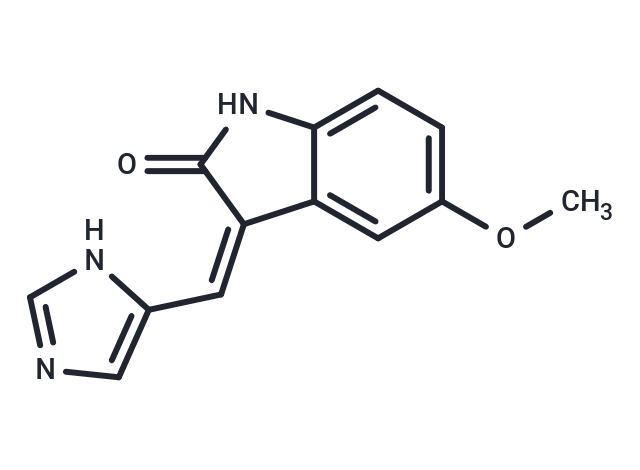Shopping Cart
- Remove All
 Your shopping cart is currently empty
Your shopping cart is currently empty

SU9516 is a potent CDK2 inhibitor with an IC50 of 22 nM and also inhibits CDK1 and CDK4, with IC50s of 40 nM and 200 nM, respectively.

| Pack Size | Price | Availability | Quantity |
|---|---|---|---|
| 1 mg | $30 | In Stock | |
| 2 mg | $43 | In Stock | |
| 5 mg | $67 | In Stock | |
| 10 mg | $105 | In Stock | |
| 25 mg | $219 | In Stock | |
| 50 mg | $396 | In Stock | |
| 100 mg | $589 | In Stock | |
| 500 mg | $1,280 | In Stock | |
| 1 mL x 10 mM (in DMSO) | $68 | In Stock |
| Description | SU9516 is a potent CDK2 inhibitor with an IC50 of 22 nM and also inhibits CDK1 and CDK4, with IC50s of 40 nM and 200 nM, respectively. |
| Targets&IC50 | CDK2:22 nM, CDK4:200 nM, CDK1:40 nM |
| In vitro | SU9516 decreases cdk2-specific phosphorylation of the retinoblastoma protein pRB, increases caspase-3 activation, and alters cell cycle in RKO and SW480 cells. SU9516 also inhibits the cell proliferation, and induces cell apoptosis in both cell lines. [1] SU9516 kills leukemic cells through inhibition of RNA Pol II CTD phosphorylation, oxidative damage and transcriptional down-regulation of Mcl-1. [2] In human T-cell leukemia Jurkat cells, SU9516 significantly enhances sensitivity to methotrexate. [3] In addition, SU9516 also suppresses Aurora-A centrosomal localization and consequent centrosome amplification. [4] |
| Kinase Assay | CDK kinase assay: Kinase assays are performed in 96-well polypropylene plates. Each reaction contained 2 μg of histone H1 at a final concentration of 10 μM [γ-33P]ATP (0.2 μCi/well; approximately twice the experimentally determined Km), 10 mM MgCl2, 1 mM DTT, 0.01% Triton X-100, and 10% glycerol in a 40 μL volume. The reaction is initiated with the addition of 20 μL enzyme (6 ng cdk2/well resulting in a final concentration of 1.6 nM), which is previously diluted 1:50–1:200 in the same buffer, and allowed to proceed for 1 h at room temperature. Reaction is stopped by the addition of 0.01 mL 10% phosphoric acid, and 25 μL of reaction mixture is transferred to P30 phosphocellulose filter mat paper. The filter mat is washed three times with 1.0% phosphoric acid, air dried, and then counted for radioactivity in a liquid scintillation counter. The cdk4 kinase assay for cyclin D1-cdk4 is carried out in a polypropylene 96-well microtiter plate format measuring the incorporation of radioactive phosphate into GST-Rb. Purified cyclin D1-cdk4 is incubated with 1 μg GST-Rb in 20 mM HEPES (pH 7.5) in the presence of 10 mM MgCl2, 1 mM DTT, 0.01% Triton X-100, and 10% glycerol. The final cdk4 concentration is 10 ng/well, or 1.6 nM. Kinase reaction is initiated by the addition of ATP at a final concentration of 10 μM ATP (twice the experimentally determined Km) and [γ-33P]ATP (1.0 μCi per well) in a 60-μL volume and allowed to proceed at room temperature for 1 h. Reaction is stopped by the addition of 0.01 ml 10% phosphoric acid, and 25 μL of reaction mixture is transferred to P30 phosphocellulose filter mat paper. The filter mat is treated as for Cdk1/Cdk2 assays. |
| Cell Research | Method: Cells are seeded at 2×103/well of white bottom 96-well plates, treated with INCB018424 from DMSO stocks (0.2% final DMSO concentration), and incubated for 48 hours at 37 ℃ in an atmosphere containing 5% CO2. Viability is measured by cellular ATP determination using the Cell-Titer Glo luciferase reagent or viable cell counting. Values are transformed to percent inhibition relative to vehicle control, and IC50 curves are fitted according to nonlinear regression analysis of the data using PRISM GraphPad. |
| Molecular Weight | 241.25 |
| Formula | C13H11N3O2 |
| Cas No. | 377090-84-1 |
| Smiles | C(=C\1/C=2C(NC1=O)=CC=C(OC)C2)\C3=CN=CN3 |
| Relative Density. | no data available |
| Storage | Powder: -20°C for 3 years | In solvent: -80°C for 1 year | Shipping with blue ice. | ||||||||||||||||||||||||||||||||||||||||
| Solubility Information | DMSO: 55 mg/mL (227.98 mM), Sonication is recommended. Ethanol: 4.8 mg/mL (19.9 mM), Sonication is recommended. | ||||||||||||||||||||||||||||||||||||||||
Solution Preparation Table | |||||||||||||||||||||||||||||||||||||||||
Ethanol/DMSO
DMSO
| |||||||||||||||||||||||||||||||||||||||||

Copyright © 2015-2025 TargetMol Chemicals Inc. All Rights Reserved.